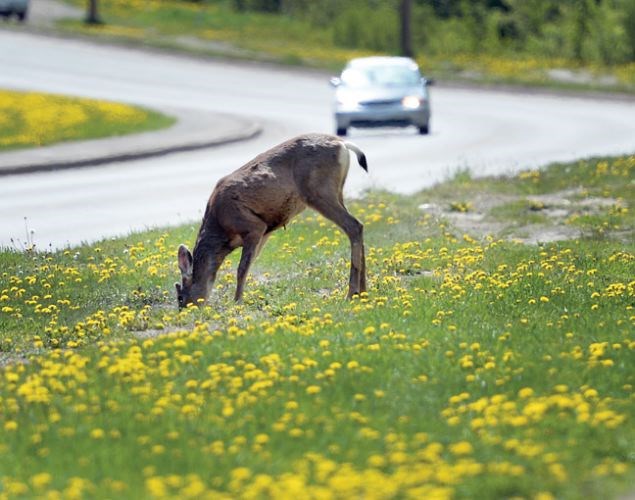Spring is springing and so are the deer.
With warmer weather conditions around the corner, deer and other wildlife are feeling the fever as they make their way toward roadways.
Deer are related to about half of all wildlife collisions in Northern B.C. while moose make up one third.
Other animals such as bears, wolves and caribou account for the remainder but it is deer that drivers need to watch out for this time of year.
"There is definitely a spring peak in collisions for deer and there are many contributing factors as to why we think this is," said Gayle Hesse, program coordinator for the B.C. Wildlife Collision Prevention Program with the B.C. Conservation Foundation.
"Deer do peak in collisions earlier, usually in April or May compared to moose who begin peaking in June. And there are many possible contributing factors," Hesse said.
"In spring, the first green grass is an attractant which also provides water in ditches along the roads. The early green vegetation is a source of forage for many wildlife species."
One of these sources is referred to as deer lick.
"This is found in wet and muddy areas where water has accumulated and dissolved containing lots of minerals and nutrients. And these are often found in ditches along roadways," Hesse said.
Long winters also have deer making their way to lower elevations with less snow.
"Weather patterns are different and right now, we are losing snow quickly," Hesse said.
Another contributing factor for moose is that moose populations are declining and so will the number of collisions.
"Also, moose are are very susceptible to the winter tick and by spring they become very agitated, so they move around more," Hesse said.
There are about 25,000 wildlife collisions a year in British Columbia but the exact number isn't always easily determined.
"ICBC takes reports from people who have been in wildlife collisions and the date and time of day can be determined but not so much the species of the animal or exact location," Hesse says.
"And the Ministry of Transportation and Infrastructure have contractors out on the roads who are obligated to remove hazardous objects from roads. This includes animal carcasses. From this, we can obtain a more specific location and species."
But there are cases where animals do not die as a result of a collision so they move from the accident scene.
"Things like this can put constraints on finding accurate data," Hesse said.
As a biologist, Hesse has done much research in the area of wildlife collisions, road ecology and raising awareness about road safety.
There are precautions and measures that can be taken when heading out on roads this spring.
"Watch for signs," Hesse said.
"Many people are unaware that these signs are actually located in high-risk areas and aren't just placed randomly. People need to watch for these signs and listen to them."
Drivers should also slow down and drive the speed limit.
"When driving, be wildlife aware. Always look far down the road, look for ditches and flickering lights," Hesse said.
According to the Wildlife Collision Prevention program, deer whistles and reflectors are ineffective.
"Deer whistles are often too quiet or the wrong frequency so an animal's reaction is unpredictable," Hesse says. "And the Ministry of Transportation is not installing reflectors anymore. They get dirty and there is no demonstrative evidence that they reduce collisions."
An animal's reaction to a vehicle can often be unpredictable.
Deer often swerve in front of vehicles by twisting or dodging to avoid predators. As a driver, it's important to remember to use your brakes, not your wheel and stay in control.
And often, if one deer crosses the road, others will usually follow behind.
"If involved in a collision involving an animal, it's important to stay at the scene," Hesse says.
"Everyone has a duty of care to other drivers to stay. There have been lawsuits where drivers have driven off and left the animals behind and this could be dangerous to other drivers," Hesse said.
If involved in a wildlife accident, motorists should pull off the road and turn on their hazard lights.
Call police if there is damage over $1,000 or if there are any injuries.
If there is a dead or injured animal on the road, drivers should call the Conservation Officer Service.
For more information regarding wildlife accidents, visit www.wildlifecollisions.ca.



